How Long Can You Keep Insulin Out of the Refrigerator?
The ultimate goal of insulin therapy is to mimic normal insulin levels. Unfortunately, current insulin replacement therapy tin can just approximate normal insulin levels. Insulin therapy for type 2 diabetes ranges from 1 injection a day to multiple injections and using an insulin pump (continuous subcutaneous insulin infusion – CSII). The more than frequent the insulin injections, the better the approximation of natural or normal insulin levels. Discuss with your medical provider the insulin regimen that is best for you.
On this page you will larn about:
- Normal or nondiabetic insulin release
- Principles of insulin replacement therapy
Normal or Non-diabetic blood sugar levels and insulin release from the pancreas
Natural insulin (i.e. insulin released from your pancreas) keeps your blood sugar in a very narrow range. Overnight and between meals, the normal, non-diabetic blood sugar ranges betwixt 60-100mg/dl and 140 mg/dl or less after meals and snacks.
See the motion picture below of blood sugar levels throughout the day in someone who does not take diabetes.
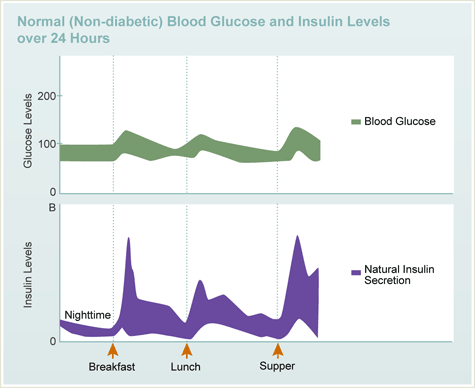
To go along the blood glucose in a narrow range
throughout the day, there is a low steady secretion of insulin overnight, fasting and between meals with spikes of insulin at mealtimes. Adapted: Jacobs DM Care 20:1279, 1997
To proceed the blood saccharide controlled overnight, fasting and between meals, your body releases a low, background level of insulin. When you lot swallow, there is a big burst of insulin. This surge of insulin is needed to dispose of all the carbohydrate or sugar that is getting captivated from your meal. All of this happens automatically!
More Nigh Natural Insulin Release
Insulin is continuously released from the pancreas into the blood stream. Although the insulin is quickly destroyed (5-6 minutes) the effect on cells may last one-i/2 hours. When your body needs more insulin, the blood levels chop-chop rising, and, the converse – when y'all demand less, the blood levels rapidly fall — The situation is different when y'all have diabetes and are getting insulin replacement therapy. Once you take injected a dose of insulin, it is going to get absorbed into your bloodstream whether you lot need it or not.
At mealtime, a little insulin is released even every bit you are start smelling or chewing the food. This gets your body set up to receive the sugar load from the meal. Then as yous swallow and the nutrient is digested, the sugar levels rise which causes a surge of insulin. The insulin levels rapidly climb and height in near 45 minutes to 1 hour before falling back to the background or basal levels – The situation is dissimilar when yous have diabetes and are getting insulin replacement therapy. You have to calculate how much carbohydrate you are going to eat and how much insulin you will demand. And y'all accept to endeavor to mimic natural overnight, fasting (or between meals) and mealtime insulin release with injected insulin.
Come across the picture below illustrating overnight, fasting and between meals insulin, and the large spikes of insulin that accompany meals.
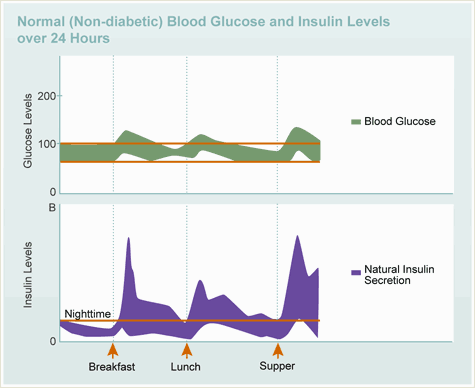
To proceed the claret glucose in a narrow range overnight, fasting and between meals, there is a low basal/groundwork secretion of insulin. Adapted: Jacobs DM Care 20:1279, 1997
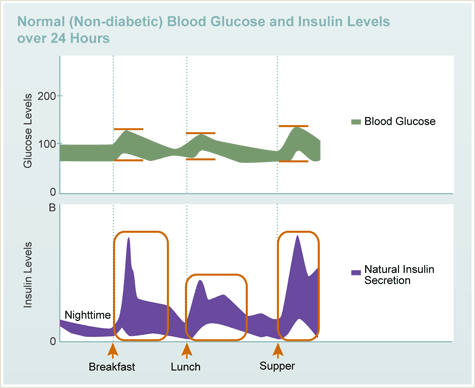
To control the blood glucose while eating, there is a rapid burst of insulin at mealtimes. These mealtime surges of insulin meridian within about 45 minutes and and then fall dorsum to the basal/background levels. Adapted: Jacobs DM Care 20:1279, 1997
Principles of insulin replacement
When you have type 2 diabetes and don't have enough of your own insulin, or cannot take other medications to control your blood sugar, you lot will demand to offset insulin therapy.
The insulin therapy tries to mimic natural or non-diabetic insulin secretion. There are 2 components of insulin therapy:
ane. Background or basal insulin replacement

Intensive insulin therapy tries to duplicate the torso's natural pattern of insulin secretion. With intensive insulin therapy you need a low steady corporeality of insulin overnight, while fasting and between meals as illustrated by the dashed line. Adapted: Jacobs DM Care xx:1279, 1997
- Controls glucose overnight and between meals past keeping fat in fatty tissue and curbing glucose production from the liver.
- Provides a low, continuous level of insulin.
- Can be a long-acting insulin, which you lot inject once or twice daily such as the insulin analogs, insulin glargine, insulin detemir and NPH.
- Or can exist a rapid-interim insulin continuously infused under the skin, if y'all are using an insulin pump.
- Represents about l% or one-half of the body's daily insulin requirements.
two. Bolus insulin replacement
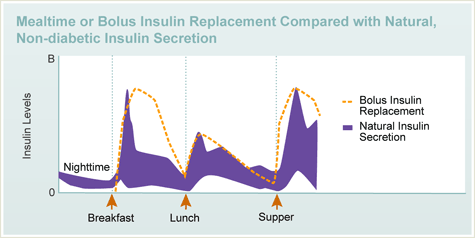
Intensive insulin therapy tries to indistinguishable the body's natural blueprint of insulin secretion. With intensive insulin therapy you lot need a rapid surge of insulin at mealtimes as illustrated by the aureate lines Adapted: Jacobs DM Intendance twenty:1279, 1997
There are two kinds of bolus replacement:
Mealtime Bolus – to cover the carbohydrate in the repast or snack.
High Blood Sugar Correction Bolus – provides extra insulin to return the blood sugar back to the target level when your blood saccharide is too high.
- Bolus Insulin is usually provided by rapid-acting insulin analogs, such as insulin aspart, insulin Lyspro, and insulin glulisine or Regular insulin.
- Represents about 10% to twenty% of the daily insulin requirement at each meal, or about l% of the torso'south daily insulin needs.
Read most the unlike types and characteristics of insulin that are suitable for basal and bolus insulin.
Some people with blazon two diabetes need simply background/basal insulin replacement, others will need just bolus insulin replacement, and still other will need both basal and bolus insulin schedules. Talk with your provider about the insulin regimen that is about suitable for you lot.
Learn more than almost :
- Types and feature of insulin medications
- Insulin administration
- Designing an insulin regimen
- Calculating your insulin dose
- Intensive insulin therapy
- Sliding scale insulin therapy
- Insulin pump therapy
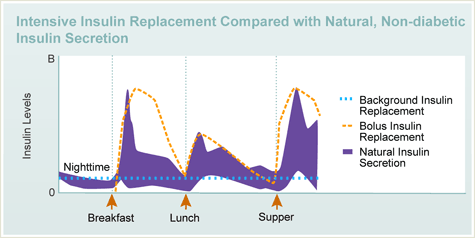
Intensive insulin therapy tries to duplicate the body'south natural blueprint of insulin secretion. With intensive insulin therapy you need a low steady level of insulin overnight, fasting, and between meals, and a rapid surge of insulin at mealtime. Adjusted: Jacobs DM Intendance xx:1279, 1997
Self-assessment Quiz
Cocky assessment quizzes are available for topics covered in this website. To find out how much yous have learned aboutInsulin Therapy, have our self cess quiz when you lot accept completed this section. The quiz is multiple choice. Please choose the single all-time respond to each question. At the end of the quiz, your score volition display. If your score is over 70% right, you are doing very well. If your score is less than lxx%, you can return to this department and review the information.
bustamantefors1956.blogspot.com
Source: https://dtc.ucsf.edu/types-of-diabetes/type2/treatment-of-type-2-diabetes/medications-and-therapies/type-2-insulin-rx/insulin-basics/
0 Response to "How Long Can You Keep Insulin Out of the Refrigerator?"
Post a Comment